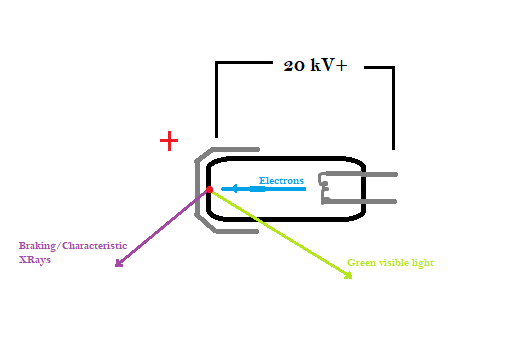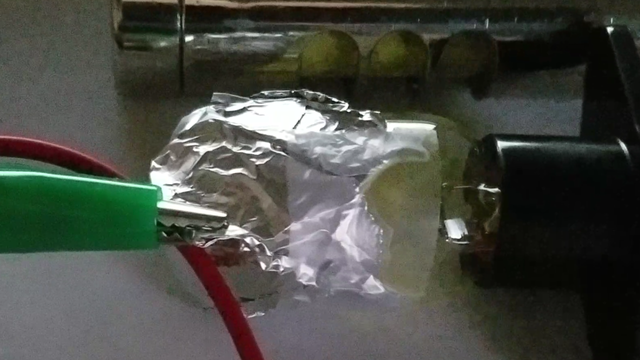How to produce XRay radiation using a salvaged light bulb
Here's how to use an incandescent light bulb from a microwave oven as a XRay producing vacuum tube. Since I mentioned this in my last post I thought I'd write a somewhat brief post elaborating on this since it's a pretty cool way to use a salvaged part, or at least I think it is. I had a section about this in my old XRay post but I think it deserves its own post.
Overview
Look inside your microwave oven. You'll see a bright yellow light illuminating the inside of the chamber. Every microwave oven I've seen uses an incadescent filament light bulb to accomplish this. If you take apart a microwave (warning, this is quite unsafe. Please see my previous post for instructions on how to do this safely) you can remove this light bulb. The interesting thing about these bulbs is that many of them are vacuum insulated. This means that if we accelerate electrons through the light bulb, they won't be stopped until they hit the glass.

A typical microwave oven light bulb
Image credit
Because the bulb is insulated by vacuum rather than an inert gas filling the inside, we can use these salvaged light bulbs to accelerate electrons and produce XRays.
Principle of Operation
Typically when producing XRays with vacuum tubes, you apply a high voltage across two conductors seperated by a vacuum. This is how I used the 2X2A tube (see previous post on this) to produce XRays. However, this is not an option for light bulbs: The only two terminals that lead into the vacuum are connected by a somewhat conductive filament. Running high voltage across the two leads would just blow out the bulb and wouldn't produce any XRays.

How XRays are produced in machines like dental XRay machines. I don't use a heated filament in my experiments because it would produce too many electrons for the current output of my supplies.
Image credit
The solution is, once again, really really simple. I found some online posts talking about testing this and decided to try it for myself several months ago. If you place aluminum foil over the top of the light bulb and tape it down, you can produce a makeshift "second electrode". Apply the positive output of a DC high voltage supply to the bulb's tin foil hat and the negative/ground output to one of the input wires to produce a strong electric field inside the bulb (I apologize if the polarity is wrong here, I didn't write enough down when I did these tests. That being said I'm pretty confident that this polarity is correct just due to how the electrons should accelerate). If the field is high enough (corresponding to a high enough voltage), electrons can tunnel out of the filament (connected to the ground/negative HV output) and accelerate towards the positive foil cap. These electrons then strike the glass in between them and the foil terminal. Upon collision, the two main types of XRays are emitted (characteristic and braking). However, since silicon (the primary component of most glass) has characteristic XRays less than 2 keV in energy, no characteristic XRays will escape the tube.
Since the glass takes up part of the space between the two HV electrodes, electrons do not accelerate to their full maximum kinetic energy (based on applied voltage). This means that a 2X2A vacuum tube, for example, will start producing detectable XRays at a lower voltage than a microwave oven light bulb (since >15keV XRays can escape the tube). Keep in mind that this explanation of why you can detect XRays from these bulbs despite the glass blocking the second electrode is something I came up with to explain it and isn't necessarily completely correct, although it is consistent with my own observations (the idea to use foil is not mine of course). If you have a better idea of what's happening here, please let me know in the comments.
An interesting side effect of running high voltage across vacuum light bulbs is flourescence. The tube I got to work let off a pale green glow when the high voltage supply was turned on. While this technically means you could figure out if you were producing XRays without a gieger counter or other radiation detector, you should never mess around with DIY XRay radiation without a way to detect it and make sure you aren't needlessly irradiating yourself. Here's a laughably bad MS Paint schematic of what's happening:

It was more difficult than using the 2X2A tube, but I did eventually get detectable XRay radiation (picked up on my geiger counter) from one of my salvaged microwave light bulbs. This was awhile ago and I took rather bad notes, but I know that my 35,000 volt supply produced XRays (as expected). Interestingly, the 15,000 volt stun gun I used to use as a small HV supply did not produce detectable XRays, although it did cause the tube to flouresce green. I think this is because of the slight electron kinetic energy reduction caused by part of the E-field going through the glass (which the fast electrons can't pass through without slowing down) as described above. Most likely, XRays were being produced, but they were too low energy to escape the tube. Silicon characteristic XRays can be produced in this tube with as little as 2,000 volts applied, but you will never detect them outside the tube. Here's a terrible quality image of a run using the stun gun this past spring, and I apologize in advance for the image quality (I still can't get my equipment to get a better picture as I am not in town). Note the green glow around the edge of the foil:
Please don't try to replicate this without knowing what you are doing. High voltage sources are dangerous and can provide an electrocution risk, and high XRay ionizing radiation doses are obviously not something to give to yourself either. You can read my previous posts on high voltage and XRays if you want to know more about the safety precautions, or look up guidelines online.
I hope you learned something from this post! Let me know if you have any questions/comments/ideas.
Thanks for reading!
Images not credited are my own. You are welcome to use them with credit.

It's fascinating! Will you take to to other levels and try to use it?
Also, isn't it somewhat dangerous? What exactly are the safety procedures?
I want to try it, but it's scary...
You could use this to make XRay photos (with proper equipment) or as a radiation detector check source.
As for safety, standard high voltage and radiation procedures apply: Insulated gloves/shoes, only work on circuit with one hand at a time, never touch circuit while on, minimize radiation dosage by putting distance and material between you and the source, only running the tube with a geiger counter present, etc. There's quite a bit needed to make this safe, so if you do end up trying this please do so only if you have looked up a lot of safety articles online.
I don't have any future plans for using these tubes, when I did this it was just to see if it could be done. Low energy XRays aren't incredibly useful to be honest as I don't have the film needed for XRay images.
@team-solutions has promoted your work :)
Thank you for the excellent content
Great post there, keep up good work !
This replay was created using STEEMER.NET Alpha ( support STEEMER.NET Transactor / Wallet / Exchange Project here: https://steemit.com/investors-group/@cryptomonitor/steemer-net-steem-blockchain-transactor-for-windows-android-app-funding-update-243-1200-sbd-28-12-2017 )
well, nice idea but not safe at all
It's perfectly safe but only if you know what you are doing and take the necessary precautions. Without these precautions (high voltage and radiation safety) it is indeed quite dangerous, which is why nobody should attempt to replicate this without knowing very well how to do it safely.